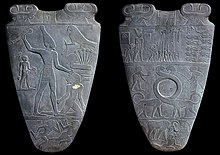
Isis was a major goddess in ancient Egyptian religion whose worship spread throughout the Greco-Roman world. Isis was first mentioned in the Old Kingdom as one of the main characters of the Osiris myth, in which she resurrects her slain brother and husband, the divine king Osiris, and produces and protects his heir, Horus. She was believed to help the dead enter the afterlife as she had helped Osiris, and she was considered the divine mother of the pharaoh, who was likened to Horus. Her maternal aid was invoked in healing spells to benefit ordinary people. Originally, she played a limited role in royal rituals and temple rites, although she was more prominent in funerary practices and magical texts. She was usually portrayed in art as a human woman wearing a throne-like hieroglyph on her head. During the New Kingdom, as she took on traits that originally belonged to Hathor, the preeminent goddess of earlier times, Isis was portrayed wearing Hathor's headdress: a sun disk between the horns of a cow.

In ancient Egyptian religion, Apis or Hapis, alternatively spelled Hapi-ankh, was a sacred bull or multiple sacred bulls worshiped in the Memphis region, identified as the son of Hathor, a primary deity in the pantheon of ancient Egypt. Initially, he was assigned a significant role in her worship, being sacrificed and reborn. Later, Apis also served as an intermediary between humans and other powerful deities.
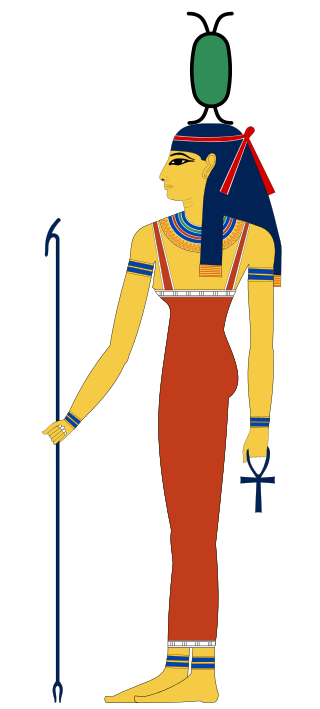
Neith was an ancient Egyptian deity, possibly of Libyan origin. She was connected with warfare, as indicated by her emblem of two crossed bows, and with motherhood, as shown by texts that call her the mother of particular deities, such as the sun god Ra and the crocodile god Sobek. As a mother goddess, she was sometimes said to be the creator of the world. She also had a presence in funerary religion, and this aspect of her character grew over time: she became one of the four goddesses who protected the coffin and internal organs of the deceased.

Hathor was a major goddess in ancient Egyptian religion who played a wide variety of roles. As a sky deity, she was the mother or consort of the sky god Horus and the sun god Ra, both of whom were connected with kingship, and thus she was the symbolic mother of their earthly representatives, the pharaohs. She was one of several goddesses who acted as the Eye of Ra, Ra's feminine counterpart, and in this form, she had a vengeful aspect that protected him from his enemies. Her beneficent side represented music, dance, joy, love, sexuality, and maternal care, and she acted as the consort of several male deities and the mother of their sons. These two aspects of the goddess exemplified the Egyptian conception of femininity. Hathor crossed boundaries between worlds, helping deceased souls in the transition to the afterlife.

Ihy is a young god in Egypt usually portrayed with the sistrum. This is in allusion to his mother Hathor who was associated with the instrument. Ihy's symbols are the sistrum and a necklace. The name Ihy depicts the joy of playing the hand instrument by Hathor, or "calf." The Egyptians themselves associated the name with the noisemaker.

Satet,Satit or Satjet, Satjit in Ancient Egyptian, Greek: Satis, also known by numerous related names, was an Upper Egyptian goddess who, along with Khnum and Anuket, formed part of the Elephantine Triad. A protective deity of Egypt's southern border with Nubia, she came to personify the former annual flooding of the Nile and to serve as a war, hunting, and fertility goddess.

Hesat is an ancient Egyptian goddess in the form of a cow. She was said to provide humanity with milk and in particular to suckle the pharaoh and several ancient Egyptian bull gods. In the Pyramid Texts she is said to be the mother of Anubis and of the deceased king. She was especially connected with Mnevis, the living bull god worshipped at Heliopolis, and the mothers of Mnevis bulls were buried in a cemetery dedicated to Hesat. In Ptolemaic times she was closely linked with the goddess Isis.

Mehet-Weret or Mehturt is an ancient Egyptian deity of the sky in ancient Egyptian religion. Her name means "Great Flood".

Meretseger was a Theban cobra-goddess in ancient Egyptian religion, in charge with guarding and protecting the vast Theban Necropolis — on the west bank of the Nile, in front of Thebes — and especially the heavily guarded Valley of the Kings. Her cult was typical of the New Kingdom of Egypt.

A sistrum is a musical instrument of the percussion family, a form of rattle, used most notably by the ancient Egyptians. It consists of a handle and a U-shaped metal frame, made of brass or bronze and ranging from 30 to 76 cm (12–30 in) in width. The frame supports sliding metal cross-bars, which may hold metal rings. When shaken, the small rings or loops of thin metal on its movable crossbars produce a sound that can vary from a soft clank to a loud jangling. Its name in the ancient Egyptian language was sekhem (sḫm) or sesheshet (sššt) because of the sound it made when it rattled. The ancient Egyptian sistrum had important associations with religious and ritualistic practices concerning various musical and joyful deities.
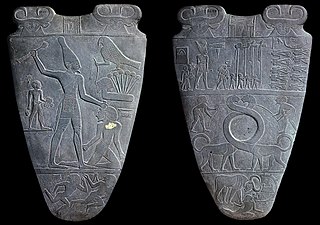
The Narmer Palette, also known as the Great Hierakonpolis Palette or the Palette of Narmer, is a significant Egyptian archaeological find, dating from about the 31st century BC, belonging, at least nominally, to the category of cosmetic palettes. It contains some of the earliest hieroglyphic inscriptions ever found. The tablet is thought by some to depict the unification of Upper and Lower Egypt under the king Narmer. Along with the Scorpion Macehead and the Narmer Maceheads, also found together in the main deposit at Nekhen, the Narmer Palette provides one of the earliest known depictions of an Egyptian king. On one side, the king is depicted with the bulbed White Crown of Upper (southern) Egypt, and the other side depicts the king wearing the level Red Crown of Lower (northern) Egypt, which also makes it the earliest known example of a king wearing both types of headdress. The Palette shows many of the classic conventions of Ancient Egyptian art, which must already have been formalized by the time of the Palette's creation. Egyptologists Bob Brier and A. Hoyt Hobbs have referred to the Narmer Palette as "The oldest Egyptian historical record".
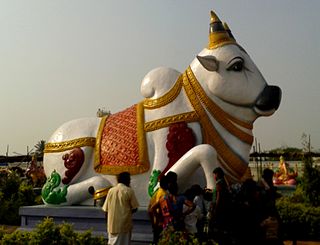
Animal worship is an umbrella term designating religious or ritual practices involving animals. This includes the worship of animal deities or animal sacrifice. An animal 'cult' is formed when a species is taken to represent a religious figure. Animal cults can be classified according to their formal features or by their symbolic content.

The Eye of Ra or Eye of Re, usually depicted as sun disk or right wedjat-eye, is an entity in ancient Egyptian mythology that functions as an extension of the sun god Ra's power, equated with the disk of the sun, but it often behaves as an independent goddess, a feminine counterpart to Ra and a violent force that subdues his enemies. This goddess, also known with the theonym Wedjat, can be equated with several particular deities, including Hathor, Sekhmet, Bastet, Raet-Tawy, Menhit, Tefnut, and Mut. The eye goddess acts as mother, sibling, consort, and daughter of the sun god. She is his partner in the creative cycle in which he begets the renewed form of himself that is born at dawn. The eye's violent aspect defends Ra against the agents of disorder that threaten his rule. This dangerous aspect of the eye goddess is often represented by a lioness or by the uraeus, or cobra, a symbol of protection and royal authority. The disastrous fury and rampages of the eye goddess and the efforts of the gods to appease her are a prominent motif in Egyptian mythology.

Anput is a goddess in ancient Egyptian religion. Her name is written in hieroglyphs as jnpwt. In English, her name also is rendered as Anupet, Input, Inpewt, and Yineput. As the female counterpart of her husband, Anubis, who was known as jnpw to the Egyptians, Anput's name ends in a feminine "t" suffix when seen as jnpwt.

Iusaaset, Iusaas, or, in Greek, Saosis, is a primordial goddess in Ancient Egyptian religion, a feminine counterpart to the male creator deity Atum. Iusaaset was depicted as a woman with a scarab beetle on her head. She was worshipped in the city of I͗wnw or Iunu, Greek Heliopolis, as was Atum. Iusaaset was associated with the acacia tree and acacias stood at the sanctuary dedicated to Iusaaset at Heliopolis.

Hu,Huw or Hiw is the modern name of an Egyptian town on the Nile, which in more ancient times was the capital of the 7th Nome of Upper Egypt.
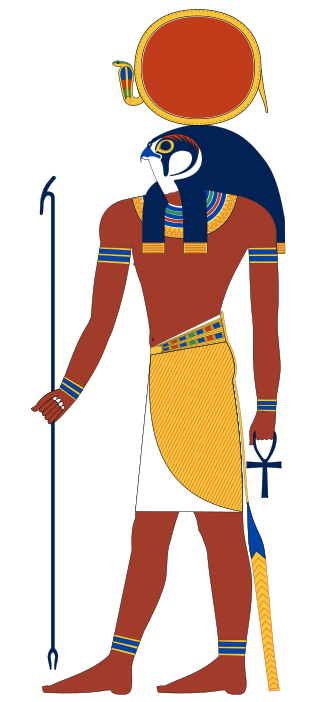
Ra or Re was the ancient Egyptian deity of the Sun. By the Fifth Dynasty, in the 25th and 24th centuries BC, he had become one of the most important gods in ancient Egyptian religion, identified primarily with the noon-day sun. Ra ruled in all parts of the created world: the sky, the Earth, and the underworld. He was believed to have ruled as the first pharaoh of Ancient Egypt. He was the god of the sun, order, kings and the sky.

Deities depicted with horns or antlers are found in numerous religions across the world. Horned animals, such as bulls, goats, and rams, may be worshiped as deities or serve as inspiration for a deity's appearance in religions that venerate animal gods. Many pagan religions include horned gods in their pantheons, such as Pan in Greek mythology and Ikenga in Odinala. Some neopagan religions have reconstructed these deities into the concept of the Horned God, representing the male aspect of divinity in Wiccan belief.

Heqet, sometimes spelled Heket, is an Egyptian goddess of fertility, identified with Hathor, represented in the form of a frog.




